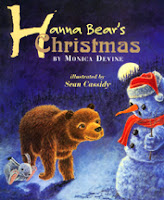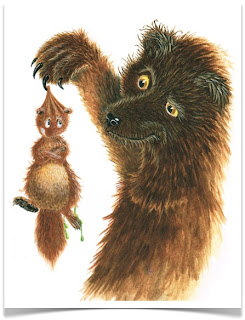Sean Cassidy is an award-winning author and illustrator, member of CANSCAIP (Canadian Society of Children's Authors, Illustrators and Performers) and the Writers' Union of Canada (WUC), and winner of the Ruth Schwartz Award, is best known for his illustrations, particularly his animals, in picture books such as:
Kazaak!
Written and illustrated by Sean Cassidy
Fitzhenry & Whiteside
2010
Hanna Bear's Christmas
Written by Monica Devine
Illustrated by Sean Cassidy
Fitzhenry & Whiteside
2007
Wake Up, Henry Rooster!
Written by Margriet Ruurs
Illustrated by Sean Cassidy
Fitzhenry & Whiteside
2006
Gummytoes
Written and illustrated by Sean Cassidy
Fitzhenry & Whiteside
2004
Good To Be Small
Written and illustrated by Sean Cassidy
Fitzhenry & Whiteside
2002
The Chicken Cat
Written by Stephanie Simpson McLellan
Illustrated by Sean Cassidy
Fitzhenry & Whiteside
2000
Depending on whether Sean writes the story as well as illustrating the book, the procedure of getting the book ready for publication will differ. The process is far easier, Sean notes, when the illustrator is also the author, as he/she will generally know what images are needed from the onset.
Once he knows the basics of a story (perhaps even before the text is received), Sean will begin sketching. He carries a sketch book with him everywhere, and, if possible, uses one sketchbook per picture book. Judging by their natural surroundings, it would not be unusual for Sean to sketch of particular tree and some rocks, or a bird at the feeder, or some running water, as images that could find their way into a book. This page from Sean's sketchbook (above left) shows some of his initial drawings and thoughts about Russell and Spike in Kazaak!
The publisher and the book designer will decide on the size and shape of the book, as well as the number of pages. The number of pages is determined by the printing and binding process, so often for picture books the page count will be 32 pages i.e., a multiple of 16. This is because the book is printed onto large sheets of paper with 8 pages per side and, with both sides printed, there would be 16 pages from a single sheet (above right). When the pages are printed and folded, these sections or bundles of 16 pages (called signatures) are easily visible at the spine side of the text block.
Having submitted any notes he makes about illustrations and discussed the illustrations that might accompany each page of text with the book designer (who decides the size and shape of the book, as well as its layout), the illustrator will go to work, matching the best illustration concept with the text on each page. Then the hard work comes in: the artwork.
Sitting down as a group, which could include the publisher, book designer, author and illustrator, they will decide which illustrations they like or recommend changing, and the book designer scans the images to produced a full-size rough with black-and white sketches and the paginated text.
At this point, Sean will use a light box to copy his sketches onto drafting velum. When approved, the velum illustrations are copied onto good quality watercolour paper. Sean has devised a method of taping down the paper on a wooden board to prevent the paper from getting wrinkled, and losing detail in the printing process.
Early in his career, Sean exclusively used coloured pencils. However, knowing that the colours of pencils could lose their vibrancy and get a bloom (which can be polished up), Sean began using acrylic paints which tend to be more forgiving than pencil. If he makes a mistake with acrylics, Sean will simply paint over it. He has chosen not to use watercolour as Sean has noted that colours begin to wash out, almost look muddy, after three runs in the printer. After all that work, it would certainly be worthwhile to ensure the integrity of the illustrations.
In order to ensure accuracy of the colours between illustrations, Sean records all paints used to create a colour for a specific use, such as recorded for Bear in Kazaak!
With all the illustrations transferred to the good art paper and painted with acrylics, Sean will cover each with tissue paper, and send them off to the publisher for multiple scans (with four colour separation) to ensure that the scan colours match the artwork colours.
If approved, sixteen pages will be printed on a single page and outsourced for printing, cutting and assemblage. Before the book goes into production, copies are sent to the publisher for a last chance to ensure the book looks as it should.
The first run, usually 2500 copies, will be completed in about 3 months, taking anywhere from 18 - 24 months to get through the whole process. And then...
Ta-da!
I encourage readers to check out Sean Cassidy's website which provides full details of his books, and opportunities for school and library visits. It's a fascinating look at a Canadian author/illustrator and a great opportunity for young readers to learn about the craft and process of illustrating. It's highly recommended!
















No comments:
Post a Comment